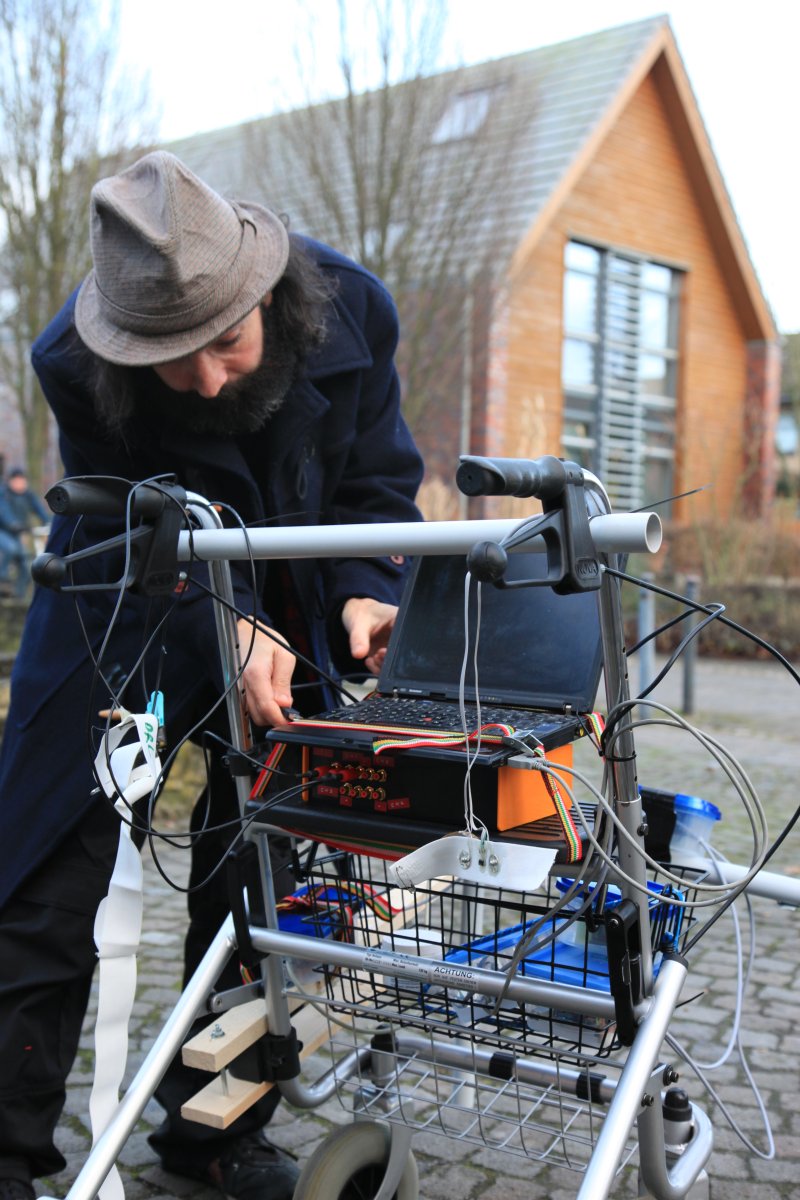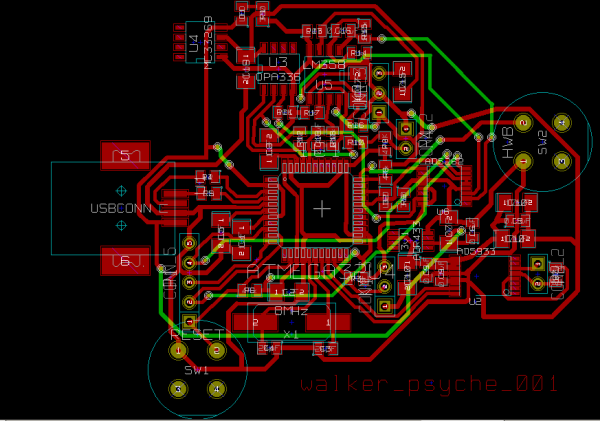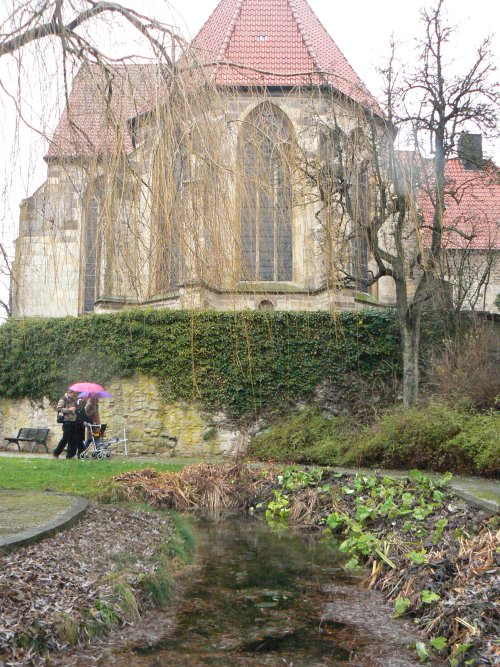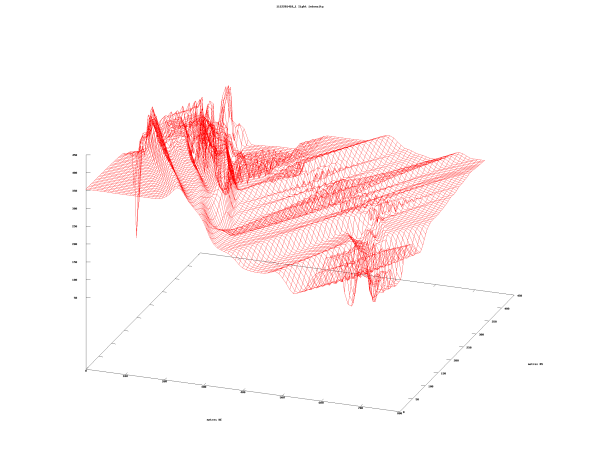Introduction
The psychogeophysics walker is a mobile, iconic platform for both urban and field exploration. The walker, designed around a disabled or aged person's walker or trolley, incorporates a range of sensors logging both the user's biological/emotional states (EEG, skin resistance, skin temperature, blood flow and breathing patterns), and the local environment (GPS, magnetic field, high and low frequency signals, temperature, soil resistance where available) enabling a series of maps to be constructed of walked locations and correlations to be established between psyche and geophysical environment. The walker is optionally equipped with inscription device and laser scanner, enabling local fields to be either engraved on specific surfaces or such surfaces to be read back (the stone tape).
The Psycho-geophysics Walker project
[An essay published in the Kraftwerk catalogue, Kuenstlerdorf Schoeppingen, 2012.]
“The conditions of the sentience had been here, he imagined, fulfilled in the method of collocation of these stones - in the order of their arrangement, as well as in that of the many fungi which overspread them, and of the decayed trees which stood around - above all, in the long undisturbed endurance of this arrangement, and in its re-duplication in the still waters of the tarn. Its evidence - the evidence of the sentience - was to be seen, he said, (and I here started as he spoke,) in the gradual yet certain condensation of an atmosphere of their own about the waters and the walls.”
[Edgar Allen Poe. The Fall of the House of Usher. 1839]
The psychogeophysics walker or rollator literally traverses two often divided domains, the environment and the psyche, advancing the thesis that we are programmed or coded by fluctuations within our environment, by subtle changes in local energy fields. Just as a substrate (doped silicon) extracted from the earth, is programmed by electronic pulses and field oscillations dictated by encoded software (in order to write this catalogue text or indeed to design the walker itself) powered by harnessed earth energies (nuclear, coal), so the equally bounded substrate of the psyche can be imagined as being coded by changes within the local geophysical environment; by changes in the earth's magnetic field under the influence of solar cycles and storms, or of distinct geological strata. And this notion can be further extended within a more paranoid trajectory with reference to a constructed or constructive signal ecology, referring to all the subtle energetic interactions between physical constructions, communication technologies such as wireless networks, mobile phone networks, RFID, television, radio, radar, power lines, generators, motors, and the emissions of all electronic devices. The human substrate is literally embedded within a vast circuit (“The ordered swirl of houses and streets, from this high angle, sprang at her now with the same unexpected, astonishing clarity as the circuit card had.” Thomas Pynchon. The Crying of Lot 49. 1966) of programmatic energies derived equally from the earth.
The walker seeks to make these encoding relations explicit, just as they are made crystalline within the science and magic of geomancy (a Western pre-reading of Feng Shui), within the short stories of Edgar Allen Poe and within the deterministic, rationalist work of neuroscientist Michael A. Persinger, author of the clearly titled paper, “On the Possibility of Directly Accessing Every Human Brain by Electromagnetic Induction of Fundamental Algorithms”. Working backwards through this list outlining psychogeophysic inspiration, it makes some sense to quote from Persinger's abstract in detail, and to place this excision within the same unbounded or undivided relation of psyche and location which is expressed within Poe's “The Fall of the House of Usher” (compressed within the opening quotation).
“Contemporary neuroscience suggests the existence of fundamental algorithms by which all sensory transduction is translated into the intrinsic, brain-specific code. Direct stimulation of these codes within the human temporal or limbic cortices by applied electromagnetic patterns may require energy levels which are within the range of both geomagnetic activity and contemporary communication networks.”
[On the Possibility of Directly Accessing Every Human Brain by Electromagnetic Induction of Fundamental Algorithms. Michael A. Persinger. 1995]
Persinger subjects to scientific methodology and scrutiny Poe's central thesis that both the arrangement of stones and a certain local atmosphere promote or encode a sentience, a consciousness, extending this theory to embrace the contemporary sighting of Unidentified Flying Objects (UFOs) and other extraterrestrial phenomena which could be aligned with a binding of the world within encoding communications technologies, an increasing energetic encoding of the earth substrate.
Designed around a disabled or aged person's wheeled walker or trolley, aiming to assist in a certain leisurely pseudo-mobility, the psychogeophysics walker can easily be viewed as both geomantic surveying apparatus and psyche-approaching measurement device, attempting as outlined to map these two now contiguous domains. The walker, as iconic platform and functional piece of field apparatus, is equipped with a range of primarily electronic sensors offering both some indication of emotional or psychic state alongside an embedding within the local geophysical environment. Sensors such as the fluxgate magnetometer (the FGM-3 from Speake Sensors) are able to measure minute fluctuations within the earth's magnetic field; distortions which can be caused by local geology (at the most extreme, by the presence of certain metals), by solar storms, or by telluric currents, perhaps indicating a correlation with lines of magnetic energy within the earth. The gradient configuration (using two such sensors to appreciate a gradient in field strength) of the fluxgates used within the walker design mirrors the use of such sensors within the practice of geophysical archaeology, a major influence on the project, which attempts to divine the distant past through the study of contemporary geomagnetic variation. Equally, the fluxgate sensor example makes evident the notion of embedding which could perhaps also be more tenuously applied to the range of so-called psyche sensors on board the walker which measure or monitor brain activity, skin resistance (galvanic skin resistance or GSR), skin temperature, blood flow and breathing patterns. The fluxgate sensor is not to be considered as consisting of some other substance than that which is measured, rather the notion of embedding implies that the embedded is not of an alien matter or concept. In this case, the fluxgate sensor, consisting of an iron core wrapped with coils of copper wire, is not qualitatively differing from its geomagnetic locale. This conceptual array could be applied to the Electroencephalography (EEG) apparatus which forms part of the walker's psychic measurement arm; the EEG simply filters and amplifies very weak electrical activity within the neurons of the brain. On the side of geomantics, further sensors (although the term implies some difference between equipment and that which is to be measured) amplify weak electromagnetic signals within the local atmosphere. The link is made apparent.
A huge amount of qualitative data concerning both environment and psyche is thus collected and stored by the psychogeophysics walker (rollator) for later analysis. An on-board GPS is always in operation when the walker is powered up, allowing for both geomantic and psychic data to be plotted against geographical location using custom software written in Python and based on gnuplot. The artificial landscapes thus generated are studied, to derive peculiar tectonics and intriguing features. The walker project can be viewed as an extension, perhaps through parody, of the Dragon project, instigated by Paul Devereux and others connected with the study of Ley lines or lines of earth energy. The Dragon project mounted “an interdisciplinary investigation into the rumour (existing in both folklore and modern anecdote) that certain prehistoric sites had unusual forces or energies associated with them.” (http://www.pauldevereux.co.uk/body_dragonproject.html web site accessed 3.1.2012) and employed a similar array of sensors on the geophysical side coupled with more qualitative psychosocial surveys conducted by dowsers and psychics. Although equally intrigued by the correlation of both psychic and geophysical anomaly, the psychogeophysics walker differs within its artistic emphasis on both embedding and associated inscription. This tight link, of inscribing and embedding of psyche within the earth substrate, and of which technology represents a simple extension, is best expressed by Poe's collision of cryptography and geomancy enacted thus within his “The Narrative of Arthur Gordon Pym” re-referenced by Smithson as follows:
“The shapes of the chasms themselves become 'verbal roots' that spell out the difference between darkness and light. Poe ends his mental maze with the sentence - 'I have graven it within the hills, and my vengeance upon the dust within the rock.' ”
[A Sedimentation of the Mind: Earth Projects. Robert Smithson. 1968]
Resources
Development notes
Software and hardware repository
Documentation
Credits
The psychogeophysics walker was developed during a residency at: Künstlerdorf Schoeppingen during November/December 2011. Images and video with thanks to: Kathrin Guenter, Loukia Richards, Christoph Ziegler, and De Lane Bredvik.



